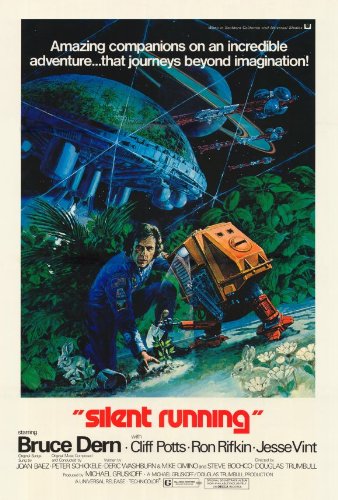 The Best Science Fiction Movies of the 1970’s
The Best Science Fiction Movies of the 1970’s
I should clarify that a film’s presence on this blog post is entirely subjective based on my experiences growing up. These were my creative formative years, during which I was discovering genre books, television shows, and movies. I was born in 1970, so really the 80’s were my true introduction to Science Fiction Horror, Thriller and Adventure — books by Asimov and Crichton and films by Cameron, Spielberg, Carpenter, and Verhoeven — but the 1970’s played a huge role in my love for the genre. Detroit Channel 7 broadcast most of the films I saw. Many had poor effects, but the stories were so powerful and the actors so committed that the movies rose above the rest of the stories that were available at the time. The themes were relevant, the plots compelling and interesting, all the base human emotions like revenge and lust and greed and hate were on full display, they spoke of issues that people dealt with every day, and they featured powerful scores and incredible directing. They were gripping.
Here they are, in chronological order. (Note the final film in the decade, how it introduced a new age of Science Fiction, and the impact it had on my writing and love for the genre.)
 BENEATH THE PLANET OF THE APES (1970)
BENEATH THE PLANET OF THE APES (1970)
Sequel to my favorite film of all time. It was a direct continuation, featuring a story of astronauts on a search for the crew of Taylor’s ship that went missing soon after launch. It didn’t follow the same formula as the first; this one involves a band of mutated humans who worship a doomsday weapon. Taylor stumbles in on them and all hell breaks loose. It ends (SPOILER!!!) with the total destruction of the Earth. Talk about a downer. As a kid, however, it made a big impact on me. Stories didn’t have happy endings all the time. You could end with the death of every single character you’d grown invested in. This movie didn’t feature the same themes as the first — religion vs. science, class struggle, and history vs. scripture — but it introduced new ones, chiefly the dangers of militarization and the fear of the atomic age.
 THE OMEGA MAN (1971)
THE OMEGA MAN (1971)
Charlton Heston again appears in a Science Fiction film in this decade. This was another iteration of the novel I AM LEGEND by Richard Matheson, which Will Smith pulled off in 2007’s gripping movie. The story features a survivor of a global pandemic and his struggles against the zombie hordes who threaten him when the sun sets. I remember watching Heston try to hold on to his sanity and his civilized nature — drinking wine and listening to classical music — while outside his barred windows the Earth had completely fallen apart. I loved this aspect of the story. Of course it turns out there are other survivors too, and Heston has to survive them as well. The right circumstances can shred the thin skin of humanity. This movie captivated me as a kid.
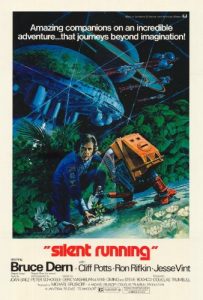 SILENT RUNNING (1972)
SILENT RUNNING (1972)
Starring Bruce Dern, the movie was a post-apocalyptic story about preserving Earth’s vegetation and wildlife in space with a plan to one day return and reseed the planet. However, corporate greed (a theme that comes up again and again in Science Fiction, especially in this era) orders the destruction of the ship’s biodomes. Dern refuses and attempts to escape, protecting Earth’s last remaining flora and fauna. It was an interesting story about the thirst for money countering rebellion for the greater good.
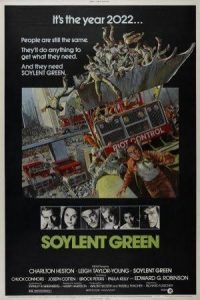 SOYLENT GREEN (1973)
SOYLENT GREEN (1973)
This is the third movie on the list that starred Charlton Heston. He was prevalent in Science Fiction films during this era. Perhaps he recognized that the biggest audiences were drawn to movies of this type. Many actors today understand this as well — Will Smith, Arnold Schwarzenegger, and Tom Cruise all appear regularly in Science Fiction thrillers; it seems as though every other movie they do is a genre film. It does seem odd to me that SF films have the biggest audiences and are the biggest box office draws, while the mainstream often looks down on SF books. It’s an odd dichotomy, one that Michael Crichton worked to overcome. Many of his novels are Science Fiction, but written with an eye to appeal to the mainstream. (He succeeded brilliantly.)
SOYLENT GREEN has a fantastic ending. It rivals Heston’s other great ending — PLANET OF THE APES (1968). I remember as a child watching SOYLENT GREEN and trying to process what Heston’s character was raving about at the end. Then it hit me …. It was a shocking notion, but it made total sense in a world suffering overpopulation, riots, a lack of resources, disease and war. This movie made a mark on me forever. The themes are gripping and relevant, characteristics of a great SF film. It’s fantastic.
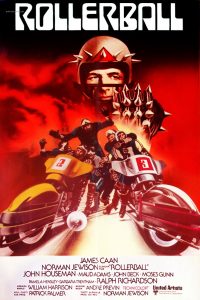 ROLLERBALL (1975)
ROLLERBALL (1975)
Such an incredible film. In the near future, corporations control society. They influence every aspect of peoples’ lives, including sport. When free will or individualism appears, they stamp it out. When Jonathan E. (James Caan) begins to grow more popular than the rollerball game itself, the chairman of the corporation orders him to retire. Jonathan refuses, so the chairman decides to destroy his career and his life. The game is interesting and brutal, and by the end of the film any rules that were there at the start are gone. Players lie dead on the track. Jonathan is the last man standing, a clear and obvious allegory of free will against corporate tyranny. The movie’s score is electric and the brutal nature of the game mesmerizing.
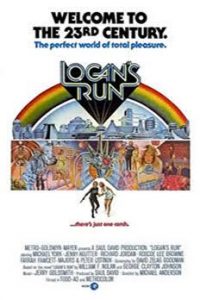 LOGAN’S RUN (1976)
LOGAN’S RUN (1976)
It’s a thriller starring Michael York, a security officer who turns twenty-one and must either die or become that which he hunts: a runner. It features the common 1970’s theme of possible planetary devastation and a way to balance life with death (of the populace as well as the environment), was based on the book by William F. Nolan, and helped introduce me to the theme of rebellion against society for the greater good.
S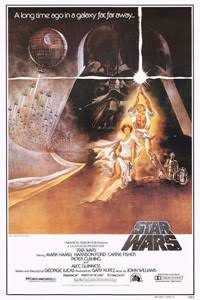 TAR WARS (1977)
TAR WARS (1977)
What can I write here that others haven’t said a million times already? This movie ushered in the modern age of SF filmmaking. I saw it fourteen times in the theaters and countless times since. I wrote about the sequel THE EMPIRE STRIKES BACK here. It displayed good vs. evil in a way I’d never seen before, and I came to love the concept of pure evil used in storytelling. It’s good to give villains backstories, but sometimes it’s best to keep them strictly evil. I learned from films that followed that it isn’t always a great idea to humanize your villains. I don’t want to feel sympathy for them. I want to hate them. This film showed good vs. evil as black vs. white. Even the color scheme of the film represents that. There’s very little color there. Just watch this YouTube video of Darth Vader from the channel “Daniel M. Kobayashi” and you’ll see what I mean.
Star Wars Episode IV – A New Hope (1977) – Darth Vader Enters – YouTube
It probably inspired my logo and website design. In this era, Darth Vader was the most evil villain ever put on film. Watching him tower over me (I was seven years old) on the screen was nerve-racking. I later saw CONAN THE BARBARIAN (1982), and realized that James Earl Jones portrayed yet another iconic villain, Thulsa Doom. I should point out that STAR WARS isn’t Science Fiction, it’s a Fantasy film about knights, a princess in captivity, and sword fighting. There’s a magic element present (the Force) and also dragons. It’s a Space Opera as well, however, so it often gets lumped into the Sci-Fi genre, but strictly speaking, it’s not. It’s also a perfect example of “The Hero’s Journey.”
 CAPRICORN ONE (1977)
CAPRICORN ONE (1977)
This movie features an interesting government conspiracy involving a faked Mars mission and a quest to kill the astronauts forced to participate in the deception. The cast is incredible: Elliot Gould, James Brolin, Sam Waterston, Hal Holbrook, Karen Black, Telly Savalas. (OJ Simpson is also in it.) Peter Hyams (OUTLAND, 2010, TIMECOP) directed and Jerry Goldsmith scored.
 CLOSE ENCOUNTERS OF THE THIRD KIND (1977)
CLOSE ENCOUNTERS OF THE THIRD KIND (1977)
As a child I found the story of Roy Neary and his obsession with an image of a mountain perplexing but fascinating. The idea that aliens might be nearby and watching us was both horrifying and interesting. This movie isn’t exactly action-packed, but the story is compelling and the concept that aliens are influencing us, interfering with us, and possibly abducting us terrified me. I enjoyed the film. It was Steven Spielberg’s follow up to JAWS. His next movies were 1941 (1979) and RAIDERS OF THE LOST ARK (1981).
 INVASION OF THE BODY SNATCHERS (1978)
INVASION OF THE BODY SNATCHERS (1978)
This is my third favorite film of all time. I wrote about it here. Starring Donald Sutherland, Leonard Nimoy, and Jeff Goldblum, it features the imposter theme which crops up in Science Fiction films again and again. I wrote about it here and spoke about it on radio here. I find that my own issues with self-esteem have contributed to my love of the theme. In the movie, Dr. Miles Bennell becomes convinced that people around him are changing. They are not themselves anymore. Something is taking over, and everyone is against him. As the film progresses, it descends into a frantic race for survival with the human race itself at stake. The ending is incredible. Whenever I hear “Amazing Grace,” I think of this film.
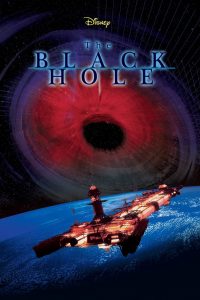 THE BLACK HOLE (1979)
THE BLACK HOLE (1979)
I saw this one in theaters. I was nine years old and haven’t seen it since. The images of the black hole with the ship suspended over it captivated me. If I watched it today I’m sure I’d notice cheesy effects and wires holding the robots aloft, but Maximilian Schell was a great villain and his evil robot (Maximilian) terrified me. This is an ongoing theme for me, in fact — brutal robots that kill. The plot device appears here, in SATURN 3 (1980) and of course in TERMINATOR (1984). I’ve never written a robot character before … or have I? (See THE FURNACE.)
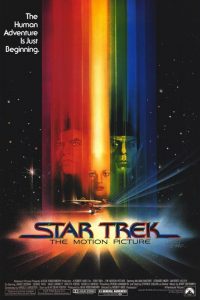 STAR TREK: THE MOTION PICTURE (1979)
STAR TREK: THE MOTION PICTURE (1979)
After a prolonged period in development hell — a series was in the planning stages before Paramount decided on a motion picture instead — the film’s visuals stunned audiences. It’s not exactly exciting … it’s more of a wondrous look at what a SF movie can visually offer … but it made a tremendous mark on Trekkies like myself who only had 79 episodes to re-watch during the ten-year period, as well as an animated series. Seeing our heroes Kirk, Spock, and McCoy on the big screen was a revelation. Star Trek on television is a thinking person’s Science Fiction show, but on film it needs more action and excitement to please audiences in a two-hour period. Still, the movie was wonderful and without it we wouldn’t have THE WRATH OF KHAN (1982). STAR TREK II is a sequel better than the first, which I wrote about here.
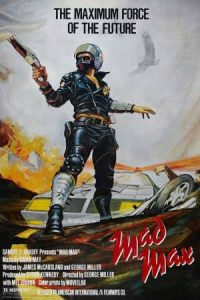 MAD MAX (1979)
MAD MAX (1979)
A man suffering the loss of his family, trying to survive in the wasteland following an apocalypse, living a brutal existence and doing anything to make it to the next day is the plot of this film and the series in general. It’s a gripping story and the film electrified audiences worldwide. It also set up an even better sequel, MAD MAX 2: THE ROAD WARRIOR (1981), which I wrote about here. George Miller, a former ER doctor, wrote and directed, and the film cemented his future in the movie industry.
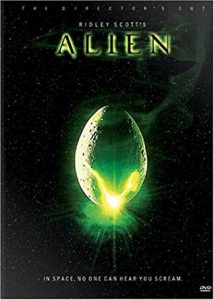 ALIEN (1979)
ALIEN (1979)
This is pure Sci-Fi horror that still stands up after a shocking forty years. Ridley Scott hit it out of the park. I remember first watching this on VHS in a department store! The chest-bursting scene was instantly iconic — even to a ten-year-old kid — and without much question this movie made a tremendous mark on my creative journey. Horror in space rears its head in THE FURNACE, THE FREEZER, and THE VOID, and the pure terror of an alien killing machine wreaking havoc in a confined location strikes me as perfection. I enjoy books and movies of this nature, as well as video games like DEADSPACE, PREY, and ALIEN: ISOLATION, and search for such properties to keep my creativity stimulated. Scott’s casting was brilliant. He put Shakespearean theater actors (John Hurt, Ian Holm) in key roles, the sets were realistic and looked like George Lucas’s “used future,” and it all gave the movie total authenticity. This one is still pulse-pounding and terrifying. If you haven’t seen it recently, or haven’t seen it at all, find it. You could say that the earlier films on the list stimulated my love for Science Fiction, and this one stoked my love for horror. It’s also interesting to note that James Cameron took the prevalent 1970’s theme of corporate greed and combined with the horror of ALIEN to make his sequel ALIENS in 1986. It was a masterstroke that cemented Cameron’s place in Science Fiction forever. I wrote about ALIENS here.
Almost Made the List
DAMNATION ALLEY
WESTWORLD
ESCAPE FROM THE PLANET OF THE APES
CONQUEST OF THE PLANET OF THE APES
TIME AFTER TIME
There they are — the Science Fiction movies in the first decade of my life that impacted my creative journey. There’s no doubt that each played a role in the type of stories that I love today. The one that left the greatest mark was ALIEN, probably because it was truly horrific, the scariest movie on the list, it capped off the 1970’s period of SF cinema, and it came at a time that led into the 1980’s and movies like THE THING (1982), TERMINATOR (1984), ROBOCOP (1987) and ALIENS (1986). (I wrote about two of these films here.) The next most important on the list is INVASION OF THE BODY SNATCHERS because of its imposter theme and pure paranoia.
I hope you enjoyed this blog post, and I hope reading about these movies of the 1970’s brought back memories of your own from this wonderful period of Science Fiction cinema. Which ones resonate the most with you? Are there any that I failed to mention?
Follow TSJ on Facebook.
Follow TSJ on Twitter.
Follow TSJ on Instagram.
Enter the contest to win a TSJ mug here.
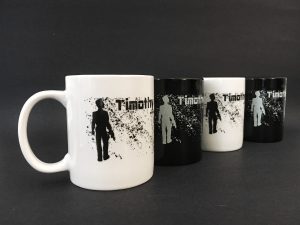


2 comments for “TSJ’s List of the Best Science Fiction Movies of the 1970’s”